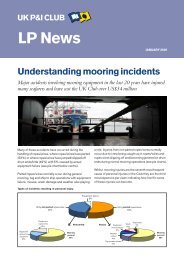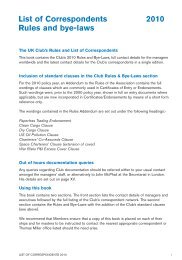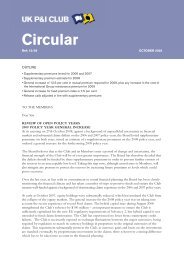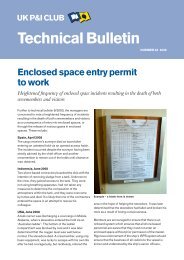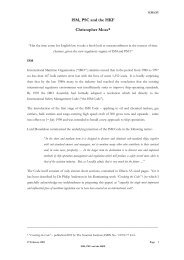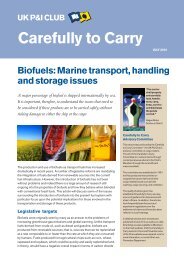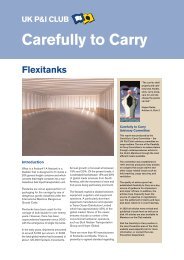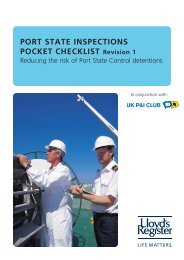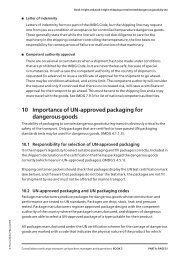Bulk Matters - UK P&I
Bulk Matters - UK P&I
Bulk Matters - UK P&I
Create successful ePaper yourself
Turn your PDF publications into a flip-book with our unique Google optimized e-Paper software.
Hold cleaning equipment in the stowed position above the deck. Note<br />
the flange on the deck wash line<br />
hose with one end fitted with a 40cm long steel uptake<br />
branch pipe and the other end open. The branch pipe<br />
was inserted into the chemical container and the open<br />
end of the transparent reinforced pipe was connected<br />
to the hand valve on the pump strainer cover using two<br />
jubilee clips. The small hand valve on the strainer cover<br />
was used to control the flow of chemical into the fire<br />
pump.<br />
Prior to starting the high-pressure sea water chemical<br />
wash, all fire hydrants and anchor wash hydrants on<br />
deck should be checked and confirmed as fully closed.<br />
The hydrant serving the hold cleaning gun should be<br />
opened and the fire and GS pump started.<br />
To avoid unnecessary chemical waste, predetermined<br />
times of injecting the chemical into the fire main should<br />
be agreed between the hold cleaning party and the<br />
person controlling the rate of chemical injection. On a<br />
110,000 dwt bulker it takes approx. 20 minutes to<br />
complete a chemical wash in each hatch, after which<br />
the chemical should be washed off using high-pressure<br />
salt water. Concurrent with the chemical wash the hold<br />
should be hand scraped with sharp long handled steel<br />
scrapers. All loose scale and flaking paint must be<br />
removed.<br />
A typical 110,000 dwt bulker will require around 100<br />
litres per hold, or 25 litres of degreasing chemical on<br />
each bulkhead.<br />
To avoid long lengths of hose delivering chemical, the<br />
chemical station should be situated as close as<br />
possible to the injection point of the fire and GS pump.<br />
The easiest way to control the rate of chemical flow is<br />
by fitting a temporary small hand operated valve on top<br />
of the strainer cover. An alternative method is to use an<br />
eductor system to suck the chemical direct from the<br />
drum into the discharge nozzle. The quantity of<br />
chemical introduced is controlled by the operator or an<br />
assistant, lifting the nozzle clear of the drum. However,<br />
this method of educting the chemical from the drum into<br />
the discharge nozzle is time consuming and more<br />
awkward for the operator and restricts his movement<br />
around the hold. In addition it carries a greater risk of an<br />
accident or spillage of degreasing chemical because<br />
the chemical drums have to be lowered into each and<br />
every hold, whereas the first method allows all the<br />
degreasing chemical to be situated at one place i.e. by<br />
the GS pump.<br />
One degreasing chemical injection station used<br />
successfully aboard a vessel consisted of: a<br />
transparent container of 120-litre capacity, graduated in<br />
10 litre units; a 5 metre transparent length of reinforced<br />
Fresh water rinse and hold preparation<br />
The final stage of hold washing is the fresh water rinse.<br />
A ship preparing for a grain cargo would be advised to<br />
carry additional fresh water in a convenient tank. This is<br />
often the after peak, which can be pumped into the fire<br />
main via a GS pump. A typical 110,000 dwt bulk carrier<br />
will require around 30 tonnes of fresh water per hatch.<br />
Prior to commencing the fresh water rinse, the fire line<br />
is flushed through with the after peak fresh water to<br />
remove all traces of salt water. If a GS pump is used,<br />
the flushing through takes a few minutes and only uses<br />
a few tonnes of fresh water. Once the fire main is clear<br />
of salt, all deck fire hydrants and anchor washers<br />
should be sighted and confirmed that they are closed.<br />
If a GS pump is to be used for the hold rinse, to prevent<br />
possible pump damage, a return line into the after peak<br />
should be set up using a hose connected from the fire<br />
main into the after peak vent.<br />
On completion of the hold fresh water rinse, all hatch<br />
entrances, hatch trunkings and hand ladders should be<br />
hand washed and fresh water rinsed using the fresh<br />
water high-pressure gun. It is not advisable to rinse and<br />
clean the access ladders and hatches before washing<br />
the main hold, because splashings from the hold<br />
bulkheads will often contaminate the freshly washed<br />
ladders. <strong>Bulk</strong>heads either side of all the hand ladders<br />
8




